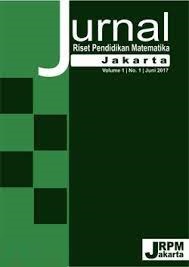Kemampuan Literasi Matematika: Kaitannya dengan Kemampuan Pemecahan Masalah
DOI:
https://doi.org/10.21009/jrpmj.v4i1.23026Keywords:
Literacy, Mathematical Literacy, PISA, Problem-solving SkillsAbstract
Mathematical literacy and problem-solving skills are very important skills in Mathematics education. Mathematical literacy is conceptually related to problem-solving skills. The purpose of writing this article is to examine the definition of mathematical literacy and problem-solving skills based on the literature and examine the relationship between the two mathematical abilities. The method in writing this article is using the literature study method. Data collection is done by reviewing articles, conference papers, and related books. From the initial 40 articles, there were only 32 articles that met the criteria, namely those published in the last 10 years and also indexed by Sinta or Scopus. From the results of the study, it was concluded that problem-solving skills are a component of competency in mathematical literacy. So that the existence of problem-solving skills in individuals will affect the ability of mathematical literacy skills.
References
Atsnan, M. F., Gazali, R. Y., & Nareki, M. L. (2018). Pengaruh pendekatan problem solving terhadap kemampuan representasi dan literasi matematis siswa. Jurnal Riset Pendidikan Matematika, 5(2), 135–146.
De Lange, J. (2003). Mathematics for Literacy. Quantitative Literacy: Why Numeracy Matters for Schools and Colleges, 75–89.
Edo, S. I., Hartono, Y., & Putri, R. I. I. (2013). Investigating secondary school students’ difficulties in modeling problems PISA-model level 5 and 6. Journal on Mathematics Education, 4(1), 41–58. https://doi.org/10.22342/jme.4.1.561.41-58
Fadillah, A., & Ni’mah. (2019). Analisis Literasi Matematika Siswa Dalam Memecahkan Soal Matematika PISA Konten Change and Relationship. Analisis Literasi Matematika Siswa Dalam Memecahkan Soal Matematika PISA Konten Change and Relationship, 3(2), 127–131.
Hensberry, K. K. R., & Jacobbe, T. (2012). The effects of Polya’s heuristic and diary writing on children’s problem solving. Mathematics Education Research Journal, 24(1), 59–85. https://doi.org/10.1007/s13394-012-0034-7
Hillman, A. M. (2014). A literature review on disciplinary literacy: How do secondary teachers apprentice students into mathematical literacy? Journal of Adolescent & Adult Literacy, 57(5), 397–406.
Jonassen, D. H. (2010). Learning to solve problems: A handbook for designing problem-solving learning environments. Routledge.
Lestari, N., & Putri, R. I. I. (2020). Using the Palembang’s Local Context in PISA-Like Mathematics Problem for Analyze Mathematics Literacy Ability of Students. Jurnal Pendidikan Matematika, 14(2), 169–182. https://doi.org/10.22342/jpm.14.2.6708.169-182
Liljedahl, P., Santos-Trigo, M., Malaspina, U., & Bruder, R. (2016). Problem solving in mathematics education. Springer Nature.
Maharaj, A., & Wagh, V. (2016). Formulating tasks to develop HOTS for first-year calculus based on Brookhart abilities. South African Journal of Science, 112(11–12), 1–6. https://doi.org/10.17159/sajs.2016/20160139
Mahdiansyah, M., & Rahmawati, R. (2014). Literasi matematika siswa pendidikan menengah: Analisis menggunakan desain tes internasional dengan konteks Indonesia. Jurnal Pendidikan Dan Kebudayaan, 20(4), 452–469.
Mansur, N. (2018). Melatih Literasi Matematika Siswa dengan Soal PISA. Prisma, 1, 140–144.
Muzaki, A., & Masjudin, M. (2019). Analisis Kemampuan Literasi Matematis Siswa. Mosharafa: Jurnal Pendidikan Matematika, 8(3), 493–502.
Novita, R. (2012). Exploring Primary Student’s Problem-Solving Ability by Doing Tasks Like PISA’s Question. Indonesian Mathematical Society Journal on Mathematics Education, 3(2), 133–150.
Ojose, B. (2011). Mathematics literacy: Are we able to put the mathematics we learn into everyday use. Journal of Mathematics Education, 4(1), 89–100.
Oktaviyanthi, R., & Agus, R. N. (2019). Eksplorasi Kemampuan Pemecahan Masalah berdaarka Kategori Proses Literasi Matematis. Jurnal Pendidikan Matematika, 13(2), 163–184.
Osman, S., Yang, C. N. A. C., Abu, M. S., Ismail, N., Jambari, H., & Kumar, J. A. (2018). Enhancing students’ mathematical problem-solving skills through bar model visualisation technique. International Electronic Journal of Mathematics Education, 13(3), 273–279.
Prabawati, M. N. (2018). Analisis Kemampuan Literasi Matematik Mahasiswa Calon Guru Matematika. Mosharafa: Jurnal Pendidikan Matematika, 7(1), 113–120.
Rohmah, M., & Sutiarso, S. (2018). Analysis problem solving in mathematical using theory Newman. Eurasia Journal of Mathematics, Science and Technology Education, 14(2), 671–681. https://doi.org/10.12973/ejmste/80630
Rusmining, R. (2017). Analysis of Mathematics Literacy of Students of Mathematics Education Department Viewed from Process Components. Unnes Journal of Mathematics Education, 6(3), 384–390.
Scherer, R., & Beckmann, J. F. (2014). The acquisition of problem solving competence: evidence from 41 countries that math and science education matters. Large-Scale Assessments in Education, 2(1), 1–22.
Schleicher, A. (2019). PISA 2018: Insights and Interpretations. OECD Publishing.
Stacey, K. (2011). The PISA View of Mathematical Literacy in Indonesia. Indonesian Mathematical Society Journal on Mathematics Education, 2(2), 95–126.
Sumirattana, S., Makanong, A., & Thipkong, S. (2017). Using realistic mathematics education and the DAPIC problem-solving process to enhance secondary school students’ mathematical literacy. Kasetsart Journal of Social Sciences, 38(3), 307–315.
Syawahid, M., & Putrawangsa, S. (2017). Kemampuan literasi matematika siswa SMP ditinjau dari gaya belajar. Beta: Jurnal Tadris Matematika, 10(2), 222–240.
Tambychik, T., & Meerah, T. S. M. (2010). Students’ difficulties in mathematics problem-solving: What do they say? Procedia - Social and Behavioral Sciences, 8(5), 142–151. https://doi.org/10.1016/j.sbspro.2010.12.020
Umbara, U., & Suryadi, D. (2019). Re-interpretation of mathematical literacy based on the teacher’s perspective. International Journal of Instruction, 12(4), 789–806. https://doi.org/10.29333/iji.2019.12450a
Utami, R. W., & Wutsqa, D. U. (2017). Analisis kemampuan pemecahan masalah matematika dan self-efficacy siswa SMP negeri di Kabupaten Ciamis. Jurnal Riset Pendidikan Matematika, 4(2), 166. https://doi.org/10.21831/jrpm.v4i2.14897
Van Merrienboer, J. J. G. (2013). Perspectives on problem solving and instruction. Computers & Education, 64, 153–160.
Wijaya, A. (2016). Students’ information literacy: A perspective from mathematical literacy. IndoMS Journal Mathematics Education, 7(2), 73–82.
Zahid, M. Z. (2020). Telaah kerangka kerja PISA 2021 : Era Integrasi Computational Thinking dalam Bidang Matematika. Prosiding Seminar Nasional Matematika, 3(March 2020), 706–713.




